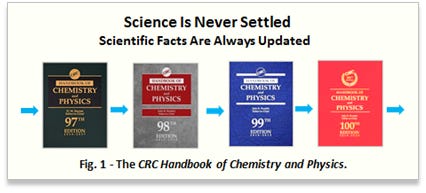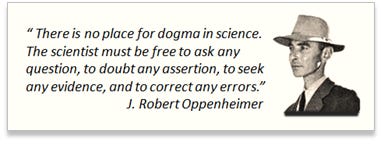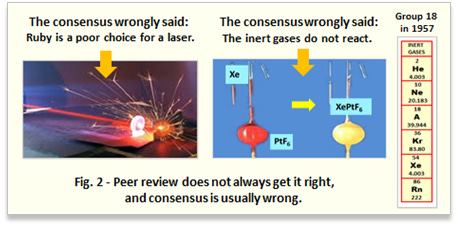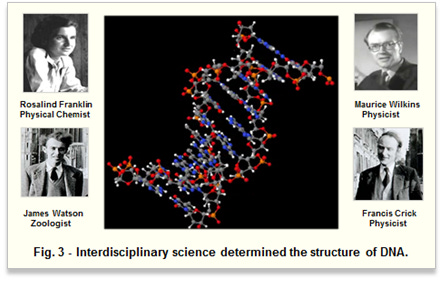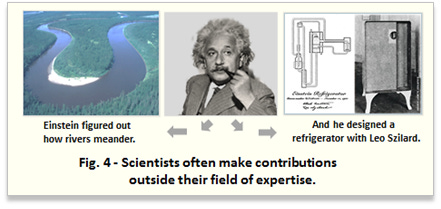The Scientific Process: What every journalist and politician should know (part 1 of 3)
Science topics
As you read this Substack version please keep in mind that subscripts and superscripts were not displayed after uploading.
Creating ambiguity where it may not exist is a common practice of journalists and politicians. That’s how global warming became climate change and carbon dioxide became carbon. The political version of science tells us that “settled science” and a “scientific consensus” determine scientific facts, and “peer review” determines the validity of those facts. All of this, of course, is quite different from real science practiced by real scientists.
Science is an iterative, self-correcting process that relies on experimental observations and direct measurements to test its theories and hypotheses. The purpose is to extend knowledge by extrapolating into new and unknown areas. What a scientist thinks or believes about a theory or hypothesis is irrelevant, because the experimental measurements are what count. Only after repeatedly verifying those measurements does a result finally become a scientific fact [1].
By definition, nothing in science can ever be “settled.” The self-correcting part of the scientific process necessarily exposes every well-established scientific fact to continual scrutiny. That’s why one of the most comprehensive collections of scientific facts, the CRC Handbook of Chemistry and Physics, is updated every year to provide the latest results of the best measurements that determine those facts.
In addition to improving existing physical constants, scientists are always trying to verify new (and old) theories or hypotheses. Sometimes a careful re-examination of previous measurements leads to new discoveries. This is why inquiry and skepticism are essential to the scientific process, as J. Robert Oppenheimer so clearly stated:
Contrary to what journalists and politicians want people to believe [2], peer review doesn't always get it right, and a scientific consensus is almost always wrong. Throughout the history of science whenever a consensus has been formed, it usually ends up being discredited, often with only one experiment.The reason is that experimental measurements and direct observations, not some tally of votes, determine what is correct in science.
The development of the first working laser and the synthesis of the first inert (noble) gas compound are two good examples of one experiment discrediting the consensus [3]. They also illustrate how the consensus can adversely affect the peer review process, making it difficult for ground-breaking scientific work to get published.
Ted Maiman, a physicist working at Hughes Research Laboratories, succeeded in making the first working laser in 1960, using a flash lamp-pumped synthetic ruby as a laser rod [4]. His remarkable result was contrary to the prevailing consensus that said ruby was a poor candidate to use as an active medium for a laser. When he submitted a paper describing his important discovery to the Physical Review Letters, it was rejected. Fortunately, Maiman’s work was eventually published in Nature, and almost overnight, many other laboratories (including Goldfinger’s) began making ruby lasers [5].
One of the basic tenets of chemistry held by the consensus was that the inert gases do not react. However, Neil Bartlett at the University of British Columbia observed otherwise. In 1962 Bartlett mixed platinum hexafluoride with xenon and obtained a yellow powder, xenon hexafluoroplatinate, the first inert gas compound. He sent his results for publication to Nature, but he received no response. Knowing the importance of his reaction, he then decided to submit his paper to the Proceedings of the Chemical Society, where it was quickly published [6]. It didn’t take long for many other chemists to repeat his important synthesis, and the new field of noble gas chemistry was born. And, as usual, the consensus was wrong.
It’s easy to find many noteworthy experimental results, including Nobel Prize-winning works [7], that were rejected by scientific journals simply because the consensus was wrong. Paul Lauterbur, the 2003 Nobel laureate in medicine, summarizes the shortcomings of peer review:
The political view of consensus has been expressed in a very compact fashion by Margaret Thatcher, who was an ice cream chemist before she ventured into politics:
While researching his book State of Fear, Michael Crichton discussed global warming with several climate practitioners, and he concluded the following about the incompatibility of consensus and science:
When a scientific consensus becomes politicized, it gains the power to eliminate criticism. Politicians and journalists can then make routine statements like “He’s not a climate expert” to quickly dismiss anyone who questions the consensus. As a result, the public gets the mistaken impression that scientists work only in extremely narrow, confined areas of research because their expertise is limited and specific.
The exact opposite of this politicized view is what actually happens in practice. Scientists often contribute to more than one field because a lot of scientific research is inter-disciplinary [8]. For example, a couple of physicists, a zoologist, and a physical chemist determined the structure of DNA. There wasn’t a biochemist in the lot, and today’s journalists and politicians would view this collaborative infringement as heresy.
Albert Einstein, a noted non-geologist and non-hydrologist, explained how rivers meander by observing the motion of tea leaves while stirring his tea in a cup [9]. And, along with Leo Szilard, he designed a refrigerator that went into pilot plant production. There is no record of either Einstein or Szilard formally studying the science and engineering of refrigeration.
So, what characterizes a good scientific researcher? A successful scientist is like a trailblazer who, upon entering a forest, knows exactly how to get from point A to point B intuitively, while most others wander about aimlessly. This is an inherent talent that cannot be taught, only enhanced, by formal education and experience. The best researchers ask meaningful questions, choose feasible research projects, and have a steadfast belief in finding a solution to a problem.
Good scientists often recognize or see things that others miss [10]. Louis Pasteur discovered optically active molecules called enantiomers when he observed (and separated) two different crystals produced from a solution of tartaric acid salts. Alexander Fleming’s observation of a mold killing some bacteria in a petri dish culture eventually led to the development of penicillin, which was used routinely as an antibiotic for many decades.
Some scientist-inventors, like Thomas Edison and Michael Faraday, made many great contributions even though they were not formally educated. Thomas Edison was the author or co-author of more (until recently) U.S. patents than any other individual, and he gave us an operational model for today’s industrial research laboratories. Michael Faraday made some of the first batteries for use in his electrochemical experiments, and he developed the guiding principles needed to make electric motors and generators.
Even today, it isn’t always the formally trained scientists who make discoveries. An amateur astronomer recently recorded the formation of a supernova, computer gamers are far better at protein folding than the best scientists, and a ham radio operator found a long-lost NASA satellite. Anyone can become a scientist if they take the time to ask questions about the world around us and use the scientific process to answer those questions. We are very fortunate that the MIT-QED types do not have a monopoly on scientific wonders.
When politicians and journalists discuss science, they usually do not use measurements and observations. Instead, they prefer to use sophistry, the ancient art of fallaciously arguing for the sake of arguing. Politicians particularly like this approach to discourse, because politics is about winning and losing, not about problem solving. William Fogg Osgood wrote a short, but famous, digression about sophistry in his elementary text on mechanics:
The steady increase in government funding in science has led to a corresponding increase in the politicization of science, as well as an overpopulation of scientific dilettantes [11-13]. By re-defining science to suit their needs, the politicians and journalists have attracted hordes of psychologists, science communicators, philosophers, and economists eager to find a use for their specific brand of scientific expertise to help contain all the various emerging crises looming on the horizon. Of course, they expect money in return for saving the world.
Some experts believe that a debate will resolve whether or not the “science” supports the existence of a particular impending crisis. Unfortunately, a debate is a political tool that resolves nothing and is used (or not used) according to the strength or weakness of the arguments needed to “win” the debate.
Politicians and journalists know this, and they use “settled science” to avoid the inconvenience of a debate when the facts do not support their cause. For example, a TV journalist who specializes in politics recites the one-sided mantra of the politicized consensus to eliminate any debate about “climate change” [14]:
Certain programs, like climate studies, have received enormous monetary windfalls to use computer models that replace real-world experimental measurements with calculations and statistics. The ability to generate any desired result with the credibility of “science” is perfect for political agendas and propaganda campaigns because the politicized science always remains untested with real measurements. The ensuing debates degenerate into “My model beats up your model” or “My average is better than your average.”
The hybridization of politics and science has other unfortunate consequences. Activists have gained control of the scientific societies, and their political opinions now litter the pages of science journals. The growing replication crisis in scientific work is directly related to the currently accepted (but previously forbidden) practice of altering and fabricating research results [15-17]. Hands-on science is rapidly becoming extinct as the combination of computer models and the sophistry of politics overwhelms and replaces real-world measurements.
The elimination of the politicized scientific consensus, with its virtual reality of adjustable data and man-made hockey sticks, is long overdue. Eventually, the self-correcting scientific process will overcome the bullying of the activists, the propaganda of the journalists, and the corruption of the politicians. When common sense finally prevails, and it will, the world can get back to paying attention to real scientists who are still doing real research the old fashion way, with measurements.
ABOUT:
C. R. Dickson studied physics and chemistry and received his Ph.D. from Columbia University as a George B. Pegram Distinguished Fellow. He has worked for Polaroid, Allied Chemical, RCA, and the Solarex Thin Film Division, a solar cell company formed as an RCA technology spinoff. He also served as a scientific advisor to the United Nations Industrial Development Organization (UNIDO) in Vienna, to the Indian Association for the Cultivation of Science (IACS) in Calcutta, and to Bharat Heavy Electricals Ltd. (BHEL) in New Delhi.
NOTES:
1. Repetition and verification refer to identical correct results obtained from measurements made independently or using different experimental methods. Repeatability does not mean getting the same wrong answer over and over, and verification is not like buying 100 copies of a newspaper to make sure the headline is true.
2. This article is a journalistic view of the consensus by a full-time science communicator. The author is misguiding by practicing politics instead of science:
“ It’s part of why scientific consensus is so remarkably valuable: it only exists when the overwhelming majority of qualified professionals all hold the same consistent professional opinion. It truly is one of the most important and valuable types of expertise that humanity has ever developed.”
3. The Michelson-Morely experiment is one of the better known examples of one experiment discrediting a scientific consensus. However, it took decades for luminiferous ether to go the way of phlogiston and spontaneous generation.
4. The original paper: Maiman, T. H. (1960). Stimulated Optical Radiation in Ruby. Nature, 187(4736), 493–494. doi:10.1038/187493a0. See also here.
5. Laser light beams do not propagate in all directions, so researchers blow “smoke” into laser beams to scatter laser light so it can be seen as in Fig. 2.
6. For a summary see: Hargittai, Istvan, "Neil Bartlett and the first noble-gas compound" (PDF). Structural Chemistry, 20: 953-959(2009), doi:10.1007/s11224-009-9526-9. See also here .
7. The Nobel Prize committee makes its share of mistakes, such as the 1926 Nobel Prize in medicine awarded to Johannes Fibiger for attributing the cause of gastric cancer to a parasitic worm. Many worthy researchers have not received the Nobel Prize due to the internal politics of this very closed club.
8. It is ironic that the study of climate is supposed to be an inter-disciplinary field, but experts in “other” disciplines like physics and chemistry are deemed “unqualified” to discuss the physics and chemistry of climate because they are not experts in climate studies. Both chemistry and physics, especially spectroscopy, is at the heart of the speculation of carbon dioxide enhanced warming by water vapor, yet the climate experts have little or no training in this crucial area.
9. Einstein’s original paper is in Die Naturwissenschaften, Vol.14, 1926 and here is a translation.
10. There is a story about Charles P. Steinmetz, on loan from GE, charging Henry Ford $1 for making an “X” on a plate to be removed to replace some windings in a generator, and $9999 for knowing where to place the “X.”
11. The mixing of science and technology with politics is not new. The introduction of the electric chair (see the War of Currents), the rise of Eugenics, and development of the atomic bomb (and its aftermath) are some notable examples. There were some obscure politics in the Mendel-Fisher controversy and Lysenkoism as pointed out by Radick (2015) in Science (pay to view, or use SciHub, doi.org/10.1126/science.aab3846).
12. This Science article is a good example of how scientific dilettantes use a combination of word pollution and sophistry: “On the bright side, he traces the development of techniques of representation that have increasingly allowed for reflective engagement with knowledge-making.”
13. A good overview of science being hi-jacked by activists and the descent into politicization is here. Another interesting politicization of science is here.
14. The TV journalist’s quote is here (between 2:00 and 2:20 min.).
15. Retraction watch provides a list of papers that have been discredited. For the replication crisis see Ioannidis, J. P. A. (2005), "Why Most Published Research Findings Are False", PLoS Medicine 2 (8): e124, doi:10.1371/journal.pmed.0020124. Also, see Why Science Is Not Necessarily Self-Correcting, John P. A. Ioannidis here.
16. A Nobel Prize winner at Cal Tech, Frances Arnold, retracted one of her recent papers because the work could not be replicated. “Careful examination of the first author's lab notebook revealed missing contemporaneous entries and raw data for key experiments.”
17. There were some publication stings demonstrating the failure of peer review: See the Sokal affair (also here) and the chocolate hoax (also here). The famous French science presenters, the Bogdanoff twins, published some work in physics journals that created a rather bizarre episode in peer review. Another unusual episode is the recent publication on police violence in Sci. Adv. 5, eaax7894 (2019) and its subsequent retraction (see here for a discussion).
18. All photos are adapted from Wikimedia Commons or they are original.



